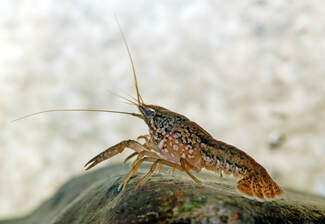Parthenogenesis is a reproductive strategy that allows reproduction without fertilization – in short, it allows members of a species to reproduce without a partner! Below are a few of these magnificent critters to celebrate this Valentine’s Day:
Marbled Crayfish
First discovered in Europe, this cousin to the Rusty Crayfish found in the South Platte River was the first crustacean detected to reproduce asexually. Researchers believe this species of crayfish, also known as the marmorkreb, to be entirely female. Scientists believe this species is only about 25 years old and resulted from a genetic mutation when two Slough Crayfish mated.
First discovered in Europe, this cousin to the Rusty Crayfish found in the South Platte River was the first crustacean detected to reproduce asexually. Researchers believe this species of crayfish, also known as the marmorkreb, to be entirely female. Scientists believe this species is only about 25 years old and resulted from a genetic mutation when two Slough Crayfish mated.

Whiptail Lizards
Another all-female cohort is the Whiptail Lizard. Whiptails can be found in the Southwest United States, Mexico, and South America. The only known unisexual reptile, whiptails evolved from hybrids of other species of lizards. To maintain genetic diversity within the species, they begin their reproductive process with twice the number of chromosomes as their sexually reproducing relatives!
Another all-female cohort is the Whiptail Lizard. Whiptails can be found in the Southwest United States, Mexico, and South America. The only known unisexual reptile, whiptails evolved from hybrids of other species of lizards. To maintain genetic diversity within the species, they begin their reproductive process with twice the number of chromosomes as their sexually reproducing relatives!

Goblin Spider – Triaeris Stenaspis
This subspecies of Goblin Spider (aka Oonopidae) is thought to be parthenogenetic, as no males of the species has ever been found. This particular Goblin Spider resides in tropical & subtropical areas all over the world. Though unconfirmed that it is entirely parthenogenetic, it has proven able to reproduce asexually under lab conditions.
This subspecies of Goblin Spider (aka Oonopidae) is thought to be parthenogenetic, as no males of the species has ever been found. This particular Goblin Spider resides in tropical & subtropical areas all over the world. Though unconfirmed that it is entirely parthenogenetic, it has proven able to reproduce asexually under lab conditions.
Sources:
- https://www.scientificamerican.com/article/asexual-lizards/
- https://www.nytimes.com/2018/02/05/science/mutant-crayfish-clones-europe.html
- https://www.nytimes.com/2018/02/05/science/mutant-crayfish-clones-europe.html
- https://www.researchgate.net/publication/236201102_Life-history_of_the_parthenogenetic_oonopid_spider_Triaeris_stenaspis_Araneae_Oonopidae


